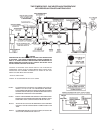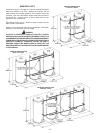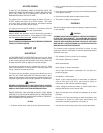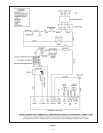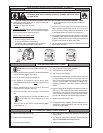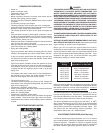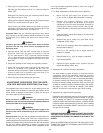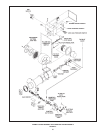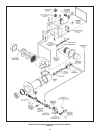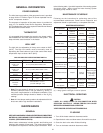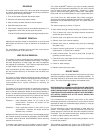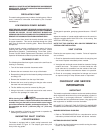
23
SEQUENCE OF OPERATION
– Power on.
– Heater in standby mode.
– Thermostat calls for heat.
– Blower motor starts.
– Blower operation closes the normally open blower prover/
blocked outlet safety pressure switch.
– On proof of airflow, Honeywell S8680J flame control module
energized.
– 45 seconds prepurge cycle begins.
– Following prepurge cycle, the pilot gas valve is energized.
– At the same time, the electronic spark generator in the module
produces a high voltage spark pulse output.
– The voltage generates a spark at the ignitor that lights the
pilot.
– If the pilot does not light (or flame signal is less than 1 micro
A) within 15 seconds system locks out and must be reset by
turning burner switch “OFF” for a minimum of 1 minute. During
system lockout, blower still runs.
– When the pilot flame is established (flame is sensed by flame
rod), the main gas valve is energized.
– Main gas flows to main burner where it’s ignited by the pilot
flame. Now heater is in Heating Mode.
– During the Heating Mode:
If gas line pressure drops below the setting point, the flame
module is de-energized, gas valves closed, blower still runs.
If gas line pressure drops below the setting point then gas
line pressure increases to above the setpoint, heater starts
again from purging cycle.
If gas line pressure fluctuates around the setpoint too quick
(less than a second) burner may still run with excessive gas
valve ON/OFF cycle you must turn off the unit immediately,
re-adjust the gas line regulator and/or install a larger gas
supply line!
If the blower inlet and/or intake hood, or flue outlet/hood is/
are blocked for any reason, the safety switches will open,
which will de-energize the flame control module.
– The spark generator is off.
– The flame module monitors pilot flame current. Should the
flame failure occur during the Heating Mode, the unit will start
again from purging cycle.
– Thermostat is satisfied, switch opens.
– Power is interrupted to the flame control module and blower
motor. Gas valves are closed.
– Heater is in Standby Mode.
– Thermostat is satisfied, switch opens.
– Power is interrupted to burner, turning off blower and ignition
control module. Solenoid and main gas valves are closed.
– Insufficient blower pressure causes safety pressure switches
to open.
WATER TEMPERATURE CONTROL
DANGER
THIS WATER HEATER IS EQUIPPED WITH AN ADJUSTABLE
THERMOSTAT TO CONTROL WATER TEMPERATURE. HOT
WATER TEMPERATURES REQUIRED FOR AUTOMATIC
DISHWASHER AND LAUNDRY USE CAN CAUSE SCALD BURNS
RESULTING IN SERIOUS PERSONAL INJURY AND/OR DEATH.
THE TEMPERATURE AT WHICH INJURY OCCURS VARIES WITH
THE PERSON'S AGE AND TIME OF EXPOSURE. THE SLOWER
RESPONSE TIME OF CHILDREN, AGED OR DISABLED PERSONS
INCREASES THE HAZARDS TO THEM. NEVER ALLOW SMALL
CHILDREN TO USE A HOT WATER TAP, OR TO DRAW THEIR
OWN BATH WATER. NEVER LEAVE A CHILD OR DISABLED
PERSON UNATTENDED IN A BATHTUB OR SHOWER.
THE WATER HEATER SHOULD BE LOCATED IN AN AREA WHERE
THE GENERAL PUBLIC DOES NOT HAVE ACCESS TO SET
TEMPERATURES.
SETTING THE WATER HEATER TEMPERATURE AT 120°F (49°C)
WILL REDUCE THE RISK OF SCALDS. Some states or provinces
require settings at specific lower temperatures.
Below you will find listed the approximate time-to-burn
relationship for normal adult skin. Short repeated heating cycles
caused by small hot water uses can cause temperatures at the
point of use to exceed the thermostat setting by up to 20F°. If you
experience this type of use, you should consider using lower
temperature settings to reduce scald hazards.
Temperature Time to Produce 2nd & 3rd
Setting Degree Burns on Adult Skin
180°F (82°C) Nearly instantaneous
170°F (77°C) Nearly instantaneous
160°F (71°C) About 1/2 second
150°F (66°C) About 1-1/2 seconds
140°F (60°C) Less than 5 seconds
130°F (54°C) About 30 seconds
120°F (49°C) More than 5 minutes
Valves for reducing point-of-use temperature by mixing cold and
hot water are available. Also available are inexpensive devices
that attach to faucets to limit hot water temperatures.
Contact a
licensed plumber or the local plumbing authority.
The water temperature is controlled by a thermostat, fig. 2, which
has two sensing elements. One sensor is located near the top
of the tank and the other is near the center. The thermostat is set
in the lowest position before the heater leaves the factory.
The dial is adjustable and may be set for 120
0
(49°C)
to 180
0
F
(82°C) water temperature, but 120
0
F (49°C) is the recommended
starting point. It is suggested the dial be placed on the lowest
setting which produces an acceptable hot water supply. This
will always give the most energy efficient operation. The
temperature control has a 4F° fixed differential.
ADJUSTMENT PROCEDURE (Initial Start-Up)
A minimum dynamic gas supply pressure of 8” w.c. for natural
gas is required before making any adjustment to the gas control
pressure regulator. Attempts to adjust the regulator during
periods of low gas supply pressure could result in overfiring of
the heater when the gas supply pressure returns to normal.





